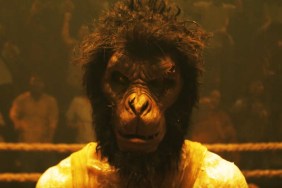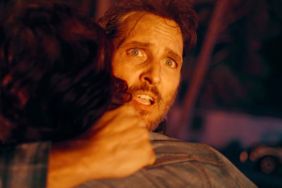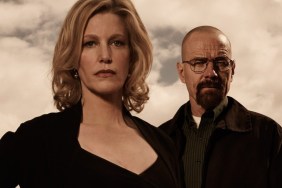On collaboration, blood & bare asses

Don’t you ever wonder what would happen if you stared at your television too long? Thanks to the new film The Signal you get to find out. An electronic transmission that’s coming through the TV starts turning people into killers.
Dan Bush, David Bruckner, and Jacob Gentry came together to create three perspectives of the flick; they each wrote, directed and edited a third of the movie which stars AJ Bowen, Scott Poythress, Justin Welborn and Anessa Ramsey. It all started through the Atlanta-based theater company, PushPush Theater; they created a concept for a story to be told by multiple different people.
Collaborating between the three was the biggest thing they had to get over. “There’s tonal differences with the film; we were all going in different directions for the story,” says David Bruckner. “It’s what Act 1 has to do, what Act 2 has to do, what Act 3 has to do. A lot of the style was created by what needed to be accomplished. One of the challenges with Act 1 in general was we had to convince the audience in a realistic fashion that this was actually happening in the world. That this could turn over in this mass scale around the world; you just have to have those logistics down so that the whole thing makes sense and flows. If you can’t willingly suspend your disbelief and buy into the idea that this is happening, we’re not going to build on it at all â you’ve just got to understand that. And it’s got to be very firm and clear.”
One thing about The Signal that is unique to other horror films: there is some male nudity and no female nudity (it’s close, but not quite there). In the opening scene, Justin Welborn gets out of bed to expose his backside. This was definitely something that needed clarification from the directors. According to Jacob Gentry, “It was a subconscious effort on Dave’s behalf; he has a fascination with male asses in movies. He actually made a trailer reel of Gerard Butler in 300 and Michael Douglas in Basic Instinct and Kevin Costner in Robin Hood. And he showed it to us, and said, ‘I want something like this in the movie.’ So what better way to open the movie than with a glistening male tush?”
Dave defends himself with, “None of that is true, but I might now carry that out. Actually, we were going to do some airbrushing on Anessa, but she got some allergic reaction to the make-up we were using before. Justin wanted to play the scene nude under the covers cause he thought it would bring him to a better place, and she agreed to it. Once we all saw his airbrushed ass in the moonlight, we were so blown away. I’ve never found a male ass to be so amazing, I can’t take my eyes off it. Just the idea of man walking up to the signal technology and Adam â it was like, ‘Wow, we have got to open up the movie like this. This will really throw everyone for a loop.”

Dan adds, “You start this Terminator story with this naked man and flesh. You don’t realize until later that it’s a robot. We open with a ’70s style Grindhouse picture, we interrupt it with the signal. Suddenly, we go into this very personal story between these lovers in a bedroom and it’s completely shifting your expectations from what it should be. So on some level, it’s kind of like, how do you conspire an audience when you don’t give them exactly what they want in the titillation standpoint. Just flirt with their expectations – we’ve got hot girls tied up and then bam, naked man walking towards the screen.”
The Signal takes the audience with Anessa and Justin’s characters trying to reconnect after her husband turns crazy due to the transmission. With Dave starting the movie off, it was Jacob’s job to keep the middle going and Dan’s to end it. “In Act 3, there’s not a lot of room for exposition,” says Dan. “It’s a tightrope you have to walk with that. The responsibility is to our own characters and our own short stories. You want to get to the point and get to the meat of the conversation as quick as possible. But at the same time, you want to respect the story telling. So it’s about the perspective of the structure of the story; each section has its own structure, and each one has its own writer and director. These guys set me up. Jacob and I went to the bar one night when I was having a tough time on mine, the ending kind of came to us. We knew, ‘That’s how we have to get to that, that’s how we have to take it.’ We had an instinct on what that structure was that we had to hit.”
Dave breaks it down: “It’s kind of an advanced version of ‘Wouldn’t it be cool if there was a movie about this?’ And the other guy chimes in with, ‘Yeah, that’s cool, but what if it were actually that plus this.’ And you have the other guy going, ‘Yeah, but you can’t really have that going; it’s got to be this.’ It’s the conversations everyone has to have with ‘Wouldn’t it be cool ifâ¦?’ Ours was just more of an advanced thing that went into a screenplay. It’s really about what excites you, and if you can excite two other guys, then you might be onto something.”

You want to talk about tons of blood? This movie has someone covered with a gash either in their head, their arm, their chest, stomach. Name the body part and they are stabbed, shot, hit, whacked, whatever. It was up to Dan, Jacob, and Dave to be as crafty as they could with their blood supply. “We had a lot of fun with the blood,” says Dan. “We had about five different blood techniques. I think we’ve all played with blood all our lives and video cameras and blood is the best combination in the world. We’re all blood snobs, we were going, ‘No, no, too much magenta; send it back. Too thick, send it back.”
And what’s the perfect blood? “We actually got one bucket during the shoot of the perfect blood. Dan was like, ‘That’s the perfect blood,’ and then the next day, we couldn’t find it; we were running around freaking out going, ‘This is not the perfect blood.'”
You can see the perfect blood, Justin’s ass, and all the madness in The Signal; it hits theaters February 22nd.



Source: Steven Chupnick









